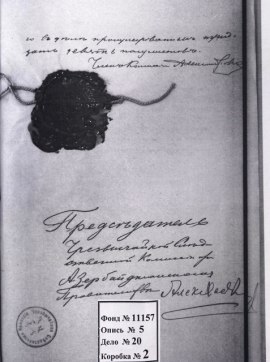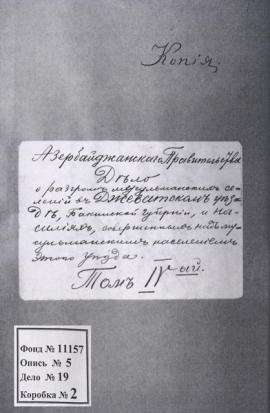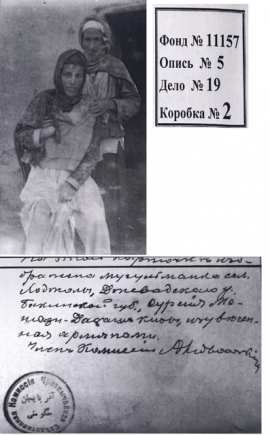On the genocide Armenians committed against Azerbaijani women (1918-1920)

The issue of Azerbaijani women, exposed to Armenian massacre in 1918-1920, as well as their future and fate have never been the subject of research in Azerbaijan history. After regaining independence, the State of Azerbaijan had an opportunity to study in great detail the tragedy of genocide victims. To bring historical truths to light regarding the tragic events, hidden in archives under the lock of top secret for dozens of years has been an actual problem.
Documents including information and facts on total assassination of Muslims by Armenians in 1918-1920 are kept in the archives. Important documents on the genocide of Azerbaijanis can be found in the Political Documents Archive, the Administrative Department of the President of Azerbaijan Republic.
1. Massacre of Turk-Muslim population
The state-level political assessment to the March genocide of 1918 of Azerbaijanis was first given by nationwide leader Heydar Aliyev. The Presidential Decree on the “Genocide of Azerbaijanis”, dated 26 March 1998, underlined the following: “The genocide committed against Azerbaijanis over and again, and lack of political and legal evaluation is an open page of history.”
The state and political figures of Azerbaijan also expressed their attitude to the bloody events and provided in-depth analysis at the beginning of the XX century. In his article on the anniversary of the March events M.A. Rasulzade called them as the “genocide of Turkish-Muslim population”. According to him, “it was a well-balanced, carefully-thought plan of Bolsheviks, implemented with the help of dashnaks.
According to A.M.Topchubashov, the outstanding state figure of his day, in order to seize the power in Baku, the Bolsheviks had been planning to kill the Muslim population for a long time, and they were ready to kill everybody including women and children.
Azerbaijani Bolsheviks also criticized crimes committed by Stepan Shaumyan-led dashnaks and Bolsheviks. Nariman Narimanov, the outstanding state figure, wrote: “How can we name the unlawful acts committed by dashnaks Amirov and Styopa Lalayev in Shamakhy?” It has emerged that in early April 1918, S. Lalayev sent to Shamakhy by S. Shaumyan gathered Muslim women and children in the mosque and burnt them alive. N. Narimanov wrote about the tragic event with deep grief: “Eventually, Muslim women with their children on a mass scale became prisoners of dashnaks, ‘the protectors of the Soviet government.’ How can we keep silence about the acts of disgusting insults towards women by ‘our protectors’- dashnaks?” Evaluating all that had happened, Mir-Jafar Baghirov, in his speech at the XXII Congress of the Communist Party of Azerbaijan, said: “Amazasp, Abram Valuyants, colonel Avetisov, as well as me, fought for the Soviet government in 1918. But, I am sorry to say that I was also a member of Amazasp’s unit and saw what outrages they had committed in Guba, let alone the acts that they committed in Shamakhy and other districts”.
To achieve the main goal - to withdraw Azerbaijanis from their ancestral lands – the Armenian armed forces occupied the lands, conducting ethnic cleansing policy and committing acts of terrorism against Muslim population. They drove out the Muslims from their homeland, attacked Azerbaijani settlements and villages, committed outrages, plundered and killed the locals.
2. The activity of Extraordinary Investigation Commission
The Azerbaijan Democratic Republic set up an Extraordinary Investigation Commission to investigate the March killings, violence and terror against Azerbaijanis in Baku. Documents of the Extraordinary Investigation Commission (EIC) are of great importance in terms of illustrating the bloody events of those years. In 1918, the young government of the independent republic had to meet certain difficult challenges. Initially, it was decided to conduct investigation of March 1918 massacre. The government of the Azerbaijan Democratic Republic, established in May 1918, made considerable efforts to investigate the criminal acts committed by Armenian nationalists against the Azerbaijani people.
Azerbaijan’s Foreign Minister Mammad Hasan Hacinski, on 15 July 1918, underlined the importance of establishing an Extraordinary Investigation Commission to investigate the violence, untold atrocities over the life and property of the civilian Muslim population. In national interests and in the interests of the suffering groups of the population, it seemed necessary to set up an organization to deal with: 1. Registration of all cases of violence; 2. Circumstances under which these atrocities were committed; 3. Identification of culprits and the size of the damage sustained. As the Minister suggested “this commission should be set up immediately because most of the things that can be easily ascertained now in the sense of interviewing people, photographing and keeping other physical evidence will later become more difficult and maybe absolutely impossible..."
3. Anti-Azerbaijani activities of the Baku Soviet in 1918
The organizer and perpetrator of the March 1918 massacre was the authority of the Baku Soviet led by Stepan Shaumyan. At the beginning of 1918, the national forces of Azerbaijan and the political position of the Musavat Party became considerably strong. And the Bolsheviks were deeply concerned about this fact. The Baku Soviet, supported by the Armenian nationalists, was preparing to destroy the Azerbaijani national movement. The plan aimed to violently change the demographic situation in Baku City and its provinces. Annihilation of the Azerbaijani population was being carried out on the state level.
The Soviet historians described those events as the Musavatists’ anti-Soviet rebel and attempt to collapse the Baku Soviet and because of alleged civil war, S. Shaumyan was compelled to use certain means of punishment. However, historical sources prove that those acts against peaceful people and plundering their property were, in the first place, committed on national grounds – it was a national massacre.
4. Genocide of women in Baku and its counties
Women and children that constituted the vast majority of unprotected layer of the population had suffered the most during the March events. In fact, neither women nor children belonged to any political party including “Musavat”.
There are too many witnesses’ testimonies on Armenians’ merciless behaviour towards women. They knew that “for Azerbaijanis the family honour is closely correlated with a woman’s ethic status. If you wish to cause a moral harm to an Azerbaijani, you should kill or dishonour his wife, sister or daughter.”
As stated in the EIC materials, 57 women bodies without ears, noses, and with stomach and genital organs cut had been buried in Baku alone. In a house, a woman, 25, was nailed alive to the wall. Armenians minced an arm, cut a breast, killed and skinned the face of the woman named Haji khanum Allahverdi gizi. Huseyn Baykara, a Turkish researcher, noted that it was very difficult for him to write about tens of thousands of victims, because Armenians had taken them naked, dragged them through, with tied hair in plaits, raped and killed them.
The investigation materials revealed the following facts: the Armenian intellectuals got actually involved in barbarism towards peaceful Azerbaijanis. A man among the intellectuals had squeezed into the room and shot eight women and a child. Some people witnessed how the Armenians would take women with them, tie to one another with their braids, and beat them with rifle butts. One of the leaders of the Armenian movement boastfully told his friends in Baku that he had raped 10 Muslim girls in Shamakhy and then killed them.
5. Genocide of Azerbaijani women in counties
Armenians violently killed the Muslim population in the counties of Nakhchivan, Karabakh, Zangazur, Javanshir, and Surmeli. In addition to the armed Armenian bandits, the government troops from the republic of Armenia were mostly involved in these areas. Not only did they kill the Muslim population, but also destroyed their economic basis. According to Aslan Khalilov, a researcher, 'Armenians pursued the policy of Armenianization and non-Islamization in Kars province' and were ready for the most outrageous crimes to hit their target.
On December 20, 1918, the Parliament of Azerbaijan in an emergency session discussed Armenia's aggression against the population of Ganja province. MP Allahverdibeyov from Karabakh on 15 December 1918 yet had enquired about “the events in Karabakh, where the Andranik-led gangs had committed violence." Maharramov, another MP, also talked about the violence against Muslim men, women and children, ignoring their gender and health.
Armenians had also committed gross acts of vandalism in other regions throughout Azerbaijan, as well as in South Azerbaijan. Andranik, the executioner of the Azerbaijani people, with his "voluntary" gang committed acts of terror against the population in Hoy, Erzincan and other cities inhabited by Azerbaijani Turks. The Armenian bandits committed savage reprisal against women, torturing and raping them. Ovanes Kachaznuni, one of the founders and leaders of Dashnakstun party, confessed, “dashnaks had had to take up arms, deploy troops and vandalize Moslem-Turk settlements.” An Armenian historian, A.Karinyan, wrote that the dashnaks’ struggle for the territory of the future national state and “approximation” of its borders had started the day after the “February Revolution”.
The conflict in 1918-1920 flared up by Armenians and mass killings of Azerbaijanis by Armenians acted as a catalyst in the processes of national self-actualization and consolidation among Azerbaijani women. The interethnic conflict did give a boost to increasing feelings of patriotism of women, thus facilitating to cement their social activities. Much noteworthy is that at a time when the state faced serious challenges that led to its weakening and dissolution in the XX century, Armenians sought to drive out Azerbaijanis from their ancestral lands in the Caucasus.
Latifa Aliyeva
Deputy Director for Scientific Affairs of the Political Documents Archive, Administrative Department of the President of Azerbaijan Republic
Gallery
AND OTHER...
-
 Book “Fuzuli’s Creativity” by Mir Jalal Out in Jordan
Book “Fuzuli’s Creativity” by Mir Jalal Out in Jordan
The book “Fuzuli’s Creativity” by the famous Azerbaijani writer and literary scholar Mir Jalal, which tells about the works of the brilliant Azerbaijani poet...
-
 Yusif Vazir Chamanzaminli’s Creativity in the Israeli Literary Magazine
Yusif Vazir Chamanzaminli’s Creativity in the Israeli Literary Magazine
“Artikl”, the popular Israeli literary magazine, has posted in Russian an excerpt from the novel “In the Crossfire” by Yusif Vazir Chamanzaminli, the outstanding...













